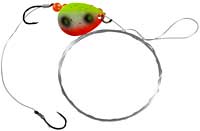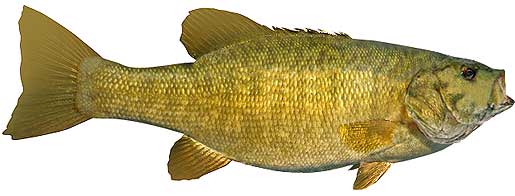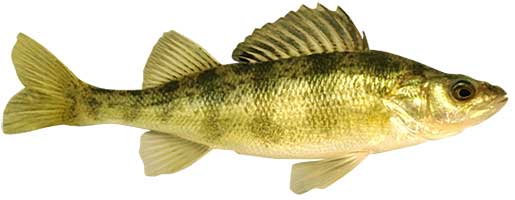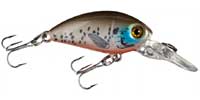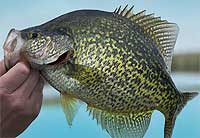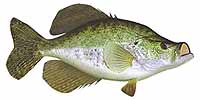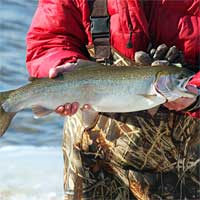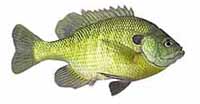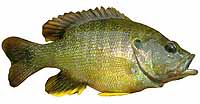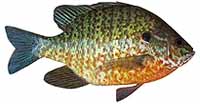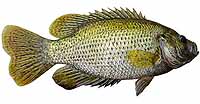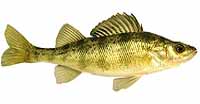Fishing Report For Burt Lake, MI
By Rick Seaman
Last updated on .
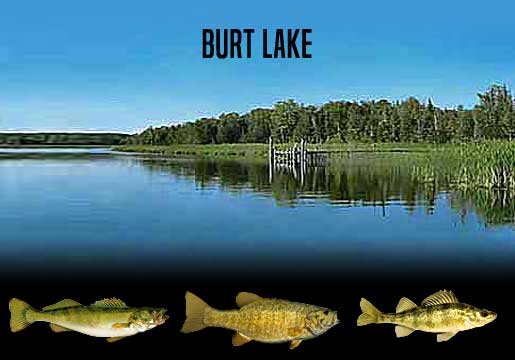
Fishing Reports
Popular Fish Species Burt Lake, MI
Walleye
Current Report: Good To Very Good
This lake is reported to be one of the better walleye lakes in the state.
FALL. Fall brings cooler temperatures to shallow water, drawing walleye and baitfish shallower. Walleye in Burt Lake tend to concentrate in migrating schools from the Chaboiganing Nature Preserve on the north to Burt Lake State Park area at the south end of the lake. Jigs, swimbaits, spoons, crankbaits, jerkbaits, and spinnerbaits are all historically good for catching walleye this time of year. Early Fall finds them in 10 to 25 feet of water. Later in Fall, they move out deeper again. Dragging jigs or worm harnesses with nightcrawlers or leeches, or bottom bouncers, around ledge drop-offs catches walleye fairly consistently. Watch for the bigger walleye to be slightly deeper than the majority of the school.
WINTER. This Winter fishing for walleye was good through the ice. Before, during and after the ice, anglers report catching them in 15 to 35 feet of water, along creek channel edges, rocky humps and ledges. They primarily feed on small fish, staying close to the bottom. After ice-out blade baits, jigs, swimbaits, spoons, deep-diving crankbaits, and worm harness spinners, are all working while deep trolling or slow drifting.
SPRING. Early Spring brings warming water in the shallows, and draws walleye here to feed, especially rocky areas and inlet channels. In Spring work the river area, and anywhere water is flowing in. Here, in 5 to 20 feet deep, they will spawn once the water warms to the mid to high 40's. When they move shallow, bright colored jigs, tipped with minnows or nightcrawlers typically catch them. Spinnerbaits, jerkbaits and crankbaits are also working when walleye are up shallow. Afterwards, they move to 20 feet and deeper around points, flats, shoals and ledges, nearby shore, often staying in close proximity to their spawning locations.
SUMMER. Water temperatures rise in Summer, and walleye fishing is good if you can get your bait deep enough. Walleye tend to concentrate in 20 to 40 feet of water, preferring the cooler temperatures. Throughout Summer, early in the morning, and from dusk to long after dark are good times to catch walleye. At those times they move slightly shallower to feed in low-light conditions. Night fishing is often good in Summer, as well. The rest of the time they are cruising flats and creek channel edges, where they are harder to locate. When the bite is slow, grubs and nightcrawlers, fished just off the bottom are catching walleye.
Smallmouth Bass
Current Report: Fair To Good
FALL. As Fall arrives, smallmouth here follow schools of baitfish into coves and bays 10 to 15 feet deep. Successful anglers are focusing on areas with weedy, rocky or gravel bottoms where smallies feed on crayfish. This is where jerkbaits, crankbaits, and slow-rolled spinnerbaits, are being successful. Later in Fall, smallies move to slightly deeper water, around 10 to 25 feet deep. Fishing shallow for smallmouth is often good on cold, windy, cloudy and rainy days.
WINTER. Winter will isolate them around deeper structure, points, flats and creek channels, often suspending in open water above these features. They can generally be found from 25 to 45 feet deep. Tube baits, jigging spoons, drop shots and Ned rigs often produce when fished with a very slow presentation. Here they hold, feeding less frequently, awaiting warmer water to return in Spring.
SPRING. When water temperatures rise into the 50's now, smallmouth have moved from deep wintering spots to shallower water, just outside spawning areas. They feeding heavily in 5 to 15 feet of water at this time, and are typically caught on jerkbaits, crankbaits, tube baits, Ned rigs, and crayfish imitating plastics. Once water warms into the high 50's, they move into shallower water, and create nests in gravel or sand areas, then lay their eggs. Females then move to deeper water and males remain to guard the eggs, and then the fry. After a couple weeks, the males also move to 15 to 25 feet deep, and feed aggressively. Crankbaits, tube baits, Ned rigs, plastic worms, spoons and swimbaits are catching smallies during this period.
SUMMER. Smallmouth bass, including an occasional trophy-size gem, are currently feeding shallow early and late in the day, where they are being caught on topwater, crankbaits, swimbaits, Ned rigs and tube baits. Smallmouth bass here feed on crawfish, shad, and small sunfish. They prefer rocky or gravel bottom areas, as this is where crayfish live. During the hotter parts of the day, they are being caught on points, humps, and ledges 20 to 45 feet deep. Often these deeper fish are part of a large school of smallmouth.
Yellow Perch
Current Report: Good To Very Good
In Spring through Fall, fish the edges of weeds in shallower water. Fat, healthy perch feed aggressively and can be caught on tube baits, worms, minnows, jigs and meal worms. The Michigan DNR reports yellow perch up to 14" are thriving here in good numbers.
FALL. Early Fall finds yellow perch feeding aggressively in 10 to 20 feet of water, especially around weed lines and drop offs, Later in the Fall, they begin migrating toward Winter holding areas, often in the deeper sections around areas with isolated weed beds. Minnows, spinners, spoons and crankbaits are ideal this time of year.
WINTER. Ice fishing for yellow perch in winter is a very popular pass time. The cold of winter drives perch deeper again in search of food and stable water conditions. Mid-depth flats are ideal Winter holding spots. Early in Winter, perch are caught when they are feeding in weedy areas, in 10 to 20 of water. Later in Winter, as the lake freezes over they descend into 25 to 45 feet of water. Fishing for perch in winter is good, using minnows, mealworms, maggots, and nightcrawlers.
SPRING. Perch spawn in Spring when the water temperature warms to the mid 50's and mid 60's. Anglers are beginning to catch them in 3 to 15 feet of water using minnows, mealworms, maggots, and nightcrawlers. Docks, weed lines, drop offs all attract yellow perch searching for a meal.
SUMMER. Fat yellow perch here feed primarily on small fish and invertebrates. Spinners, underspins, small crankbaits, mealworms, nightcrawlers and maggots are catching perch in slightly deeper water. Early and late in the day, perch feed in 8 to 15 feet of water, and around 15 to 30 feet deep mid day, around drop-offs and areas with submerged vegetation.
Fishing Video
Fish species to fish for...
Guide to fishing for largemouth bass, smallmouth bass, channel catfish, black crappie, white crappie, walleye, rainbow trout, brown trout, bluegill, green sunfish, pumpkinseed sunfish, rock bass, yellow perch, muskie and northern pike at Burt Lake in Michigan.
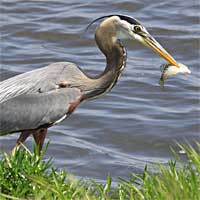 Offering anglers numerous fish species to pursue, Burt Lake is a 17,000-acre lake in the northern tip of the lower peninsula, at Indian River, MI. Walleye, smallmouth bass, yellow perch, northern pike and big muskies are the primary target of local anglers.
Offering anglers numerous fish species to pursue, Burt Lake is a 17,000-acre lake in the northern tip of the lower peninsula, at Indian River, MI. Walleye, smallmouth bass, yellow perch, northern pike and big muskies are the primary target of local anglers.
Primary fish species to catch
Click images for fishing tips and details about each species.
Today's Weather & Forecast
Fishing Boat Rentals
Click here for fishing boat rentals.
Public Boat Launch Ramps & Landings
Click here for boat ramps.
Marinas
Click here for marinas.
Fishing License
Click here for a Michigan Fishing License.
Map - Fishing & Access
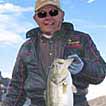 Rick Seaman is a fishing enthusiast with over five decades of fishing experience, a retired tournament fisherman, author of numerous published articles on fishing, and co-author of the book "Bass Fishing - It's not WHAT you throw, It's WHERE you throw it".
Rick Seaman is a fishing enthusiast with over five decades of fishing experience, a retired tournament fisherman, author of numerous published articles on fishing, and co-author of the book "Bass Fishing - It's not WHAT you throw, It's WHERE you throw it".
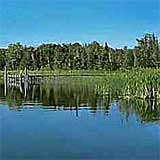 Contact Information
Contact Information
Maple Bay State Forest Campground
1700 Maple Bay Rd
Brutus, MI 49716
989 732-3541
Fishing lakes in each state
100825
Burt Lake in Michigan
MICHIGAN


Information about fishing lakes in MI.
Fishing near the northern tip of the lower MI peninsula, for bass, catfish, crappie, walleye, trout, bluegill, sunfish, perch, muskie and northern pike.





